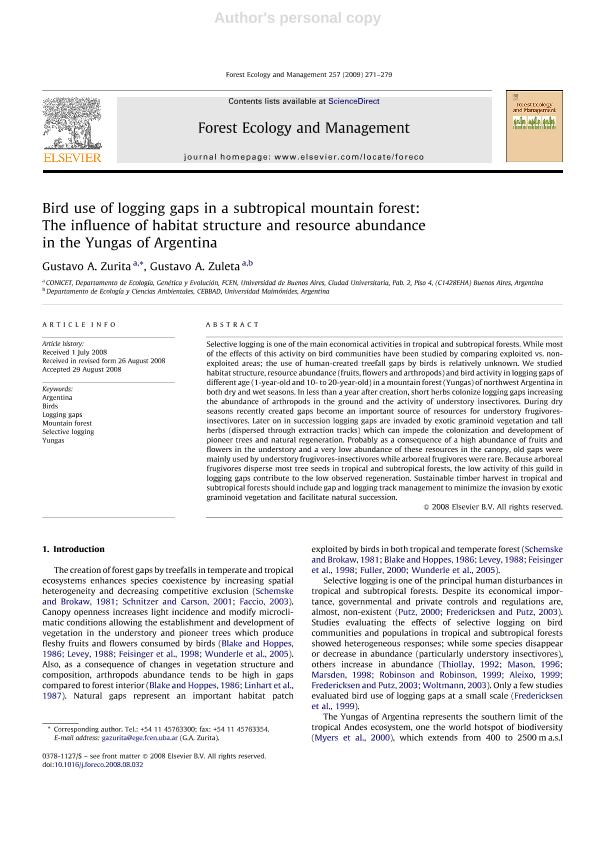Mostrar el registro sencillo del ítem
dc.contributor.author
Zurita, Gustavo Andres

dc.contributor.author
Zuleta, Gustavo Adolfo

dc.date.available
2018-09-20T19:47:19Z
dc.date.issued
2009-01
dc.identifier.citation
Zurita, Gustavo Andres; Zuleta, Gustavo Adolfo; Bird use of logging gaps in a subtropical mountain forest: The influence of habitat structure and resource abundance in the Yungas of Argentina; Elsevier Science; Forest Ecology and Management; 257; 1; 1-2009; 271-279
dc.identifier.issn
0378-1127
dc.identifier.uri
http://hdl.handle.net/11336/60512
dc.description.abstract
Selective logging is one of the main economical activities in tropical and subtropical forests. While most of the effects of this activity on bird communities have been studied by comparing exploited vs. non-exploited areas; the use of human-created treefall gaps by birds is relatively unknown. We studied habitat structure, resource abundance (fruits, flowers and arthropods) and bird activity in logging gaps of different age (1-year-old and 10- to 20-year-old) in a mountain forest (Yungas) of northwest Argentina in both dry and wet seasons. In less than a year after creation, short herbs colonize logging gaps increasing the abundance of arthropods in the ground and the activity of understory insectivores. During dry seasons recently created gaps become an important source of resources for understory frugivores-insectivores. Later on in succession logging gaps are invaded by exotic graminoid vegetation and tall herbs (dispersed through extraction tracks) which can impede the colonization and development of pioneer trees and natural regeneration. Probably as a consequence of a high abundance of fruits and flowers in the understory and a very low abundance of these resources in the canopy, old gaps were mainly used by understory frugivores-insectivores while arboreal frugivores were rare. Because arboreal frugivores disperse most tree seeds in tropical and subtropical forests, the low activity of this guild in logging gaps contribute to the low observed regeneration. Sustainable timber harvest in tropical and subtropical forests should include gap and logging track management to minimize the invasion by exotic graminoid vegetation and facilitate natural succession. © 2008 Elsevier B.V. All rights reserved.
dc.format
application/pdf
dc.language.iso
eng
dc.publisher
Elsevier Science

dc.rights
info:eu-repo/semantics/openAccess
dc.rights.uri
https://creativecommons.org/licenses/by-nc-sa/2.5/ar/
dc.subject
Argentina
dc.subject
Birds
dc.subject
Logging Gaps
dc.subject
Mountain Forest
dc.subject
Selective Logging
dc.subject
Yungas
dc.subject.classification
Otras Ciencias Biológicas

dc.subject.classification
Ciencias Biológicas

dc.subject.classification
CIENCIAS NATURALES Y EXACTAS

dc.subject.classification
Otras Ciencias Biológicas

dc.subject.classification
Ciencias Biológicas

dc.subject.classification
CIENCIAS NATURALES Y EXACTAS

dc.title
Bird use of logging gaps in a subtropical mountain forest: The influence of habitat structure and resource abundance in the Yungas of Argentina
dc.type
info:eu-repo/semantics/article
dc.type
info:ar-repo/semantics/artículo
dc.type
info:eu-repo/semantics/publishedVersion
dc.date.updated
2018-09-18T14:09:33Z
dc.journal.volume
257
dc.journal.number
1
dc.journal.pagination
271-279
dc.journal.pais
Países Bajos

dc.journal.ciudad
Amsterdam
dc.description.fil
Fil: Zurita, Gustavo Andres. Consejo Nacional de Investigaciones Científicas y Técnicas. Centro Científico Tecnológico Conicet - Nordeste. Instituto de Biología Subtropical. Universidad Nacional de Misiones. Instituto de Biología Subtropical; Argentina. Universidad de Buenos Aires. Facultad de Ciencias Exactas y Naturales. Departamento de Ecología, Genética y Evolución; Argentina
dc.description.fil
Fil: Zuleta, Gustavo Adolfo. Consejo Nacional de Investigaciones Científicas y Técnicas; Argentina. Universidad Maimónides. Área de Investigaciones Biomédicas y Biotecnológicas; Argentina. Universidad de Buenos Aires. Facultad de Ciencias Exactas y Naturales. Departamento de Ecología, Genética y Evolución; Argentina
dc.journal.title
Forest Ecology and Management

dc.relation.alternativeid
info:eu-repo/semantics/altIdentifier/doi/http://dx.doi.org/10.1016/j.foreco.2008.08.032
dc.relation.alternativeid
info:eu-repo/semantics/altIdentifier/url/https://linkinghub.elsevier.com/retrieve/pii/S0378112708006713
Archivos asociados
